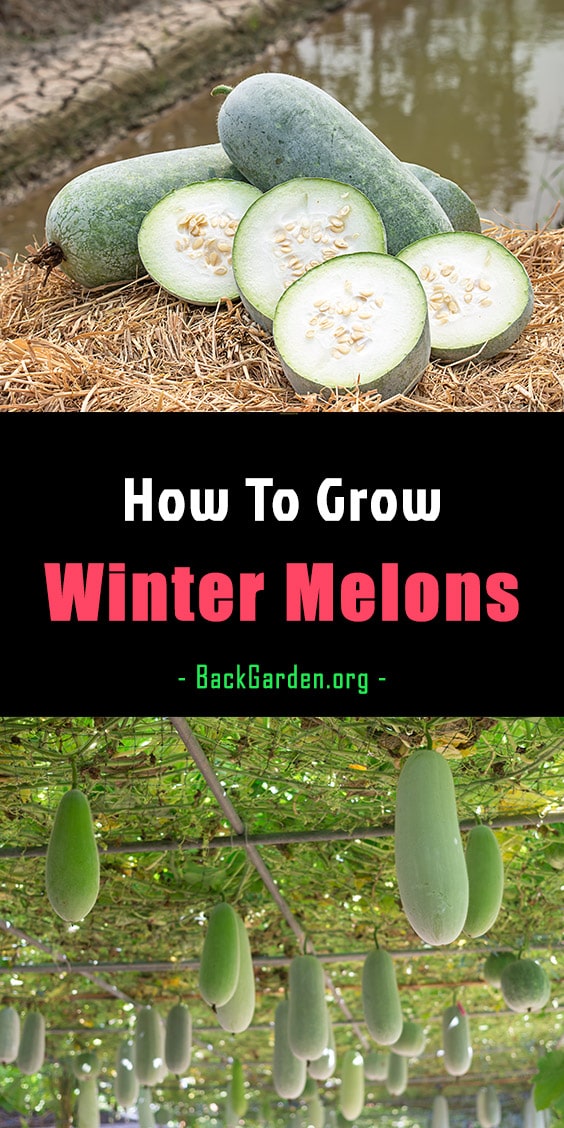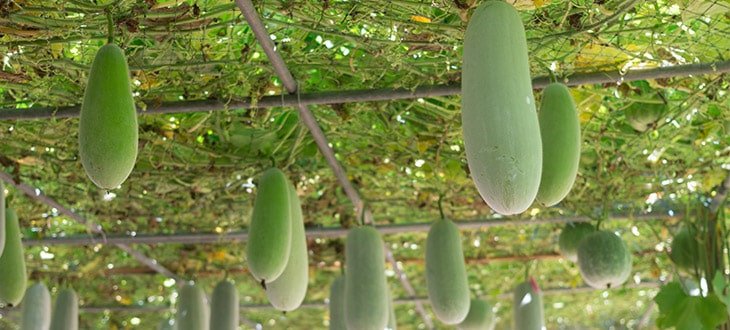Winter Melon Growing Guide
Are you interested in growing your own winter melons? This guide will teach you how to plant and care for this exotic Asian plant.
Winter Melon (scientific name Benincasa hispida) is a plant native to Southern Asia. Its exact country of origin is unknown. Different sources say that it was first cultivated in Egypt, China, Indonesia, India, Japan, or Sri Lanka. What is known for sure is that this fruit has been cultivated for thousands of years in various regions of Asia.
The name “winter melon” is more common in the Western world but has many other titles across different regions of the globe, including ash gourd, wax gourd, white gourd, Alu Puhul, Tong Qwa, Chinese preserving melon, white pumpkin, ash pumpkin, tallow gourd, etc. This usually varies from one region to another.
Disclosure: This page contains affiliate links. This means that the owner of this website might be compensated for any qualifying purchases made via these links.
Contents
Winter Melon Fruit
Winter melon plants grow as a vine and produce fruits that look very similar to squashes. The vine and its leaves also look much alike to those of squashes.
For some varieties, during the growth stage, a soft fur covers the skin of the winter melon. Later on, when the fruit reaches its maturity, this hair falls off, and a waxy coating replaces it. Hence, the alternative name of “wax gourd.” This wax coat helps to preserve the fruit for an extended period after harvesting.
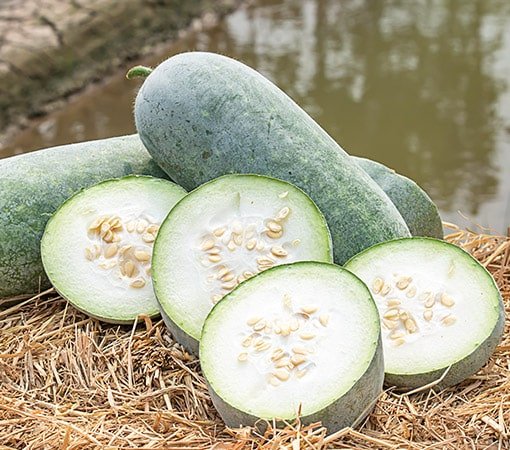
While by definition the winter melon is a fruit, it is primarily grown and consumed as a vegetable. It is prevalent in Chinese and Indian cuisine and it is mostly used as an ingredient for soups, teas, or sweet drinks.
While the leaves, fresh shoots, and tendrils are edible as well, typically, the pulp of the fruit is the part that many consume.
Unlike the watermelon, which is sweet and usually consumed raw, the winter melon is relatively tasteless when not cooked. Some compare its taste with the white part (between the pink core and the green skin) of a watermelon. I prefer to describe it like a slightly sweet cucumber.
Despite its name, the winter melon resembles more the characteristics of squashes than melons.
Besides being utilized in various recipes, the winter melon is also prevalent in traditional Asiatic medicine. It is popular in treating mild kidney issues, gastrointestinal problems, ulcers, hypertension, and more. Winter melon is also rich in fibers, minerals, low in saturated fats, and high in vitamin C and B complex.
Cultivation
Now that you know a few things about the origins of the winter melon, it’s time to learn how to grow it.
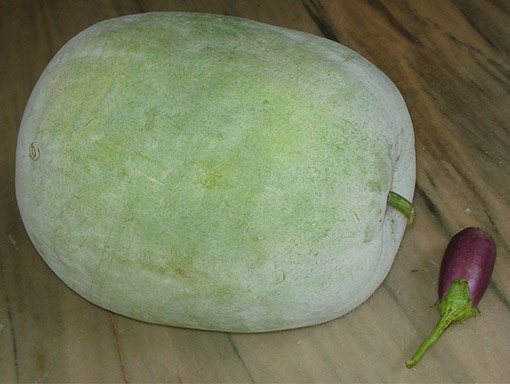
There are many varieties and hybrids of winter melons, each with distinctive colors, shapes, and sizes.
The larger species of winter melon can make fruits that weigh 20 kilograms or more. However, these can generally sustain only 1-3 fruits per plant, while the smaller types usually can make more.
In this regard, the College of Agriculture & Natural Resources of Michigan State University has conducted an experiment in 2016 where they planted eight different varieties of winter melons. At the end of the research, they were able to determine how many fruits each winter melon variety developed and the average fruit weight.
Tested winter melon varieties:
- Southern Dark Skin
- Large Oblong
- Long Giant
- Large Round
- Hybrid Small Round
- Hybrid Wonder Wax
- Hybrid Thai Small
- Hybrid Thao Nuan
From the chosen varieties, the winner for the most fruits per plant was Large Oblong, while the type that made the biggest fruit was Long Giant.
You can see the full details about this experiment on the official website of CANR.
The seeds of some varieties might also be harder to find commercially, so that’s something you should take into account. You can also find several stores that sell winter melon seeds on Amazon.
Winter melons can be planted in greenhouses, in grow bags, on raised beds, or directly in the garden. Regardless of the chosen environment, it is better not to leave the plant to grow directly over the surface of the ground.
Suspend the vines on poles, fences, rope, or some other type of trellising systems to reduce the chance of fungal diseases and pests reaching out to the fruits.
Requirements
Winter melons are annual plants, which means you have to plant it every year to get new crops.
The name “winter melon” may mislead many gardeners who try to grow this plant for the first time. It was named this way because you can store it for a long time after harvesting and because we can enjoy it even during winter.
When I first heard about winter melons, I also thought that this is some kind of plant that grows during the winter.
So if you are reading this article expecting to find a melon variety which grows in the winter, sorry to disappoint you but you won’t find it here. Planting winter melons before or during the winter would be just a waste of time since the first frost would rapidly kill it.
Temperature
Winter melons require a minimum temperature of approximately 60°F (15°C) and not more than 95°F (35°C). These plants are no-frost tolerant and require a period of extended heat to reach maturity.
The best temperature range for the growth of winter melon is somewhere between 75 and 85°F (23-30°C).
Planting
I cannot give you an exact date for when it’s the best time to plant the winter melon outside or in unheated protected areas since the climate in different countries and regions can differ quite a lot. Generally, you can establish the spring crop of winter melons in the field after the danger of the last frost has passed, and when there are no more sudden temperature fluctuations.
In tropical regions where there’s no winter and temperatures are consistently high throughout the year, you can grow and harvest up to three crops of winter melon per year.
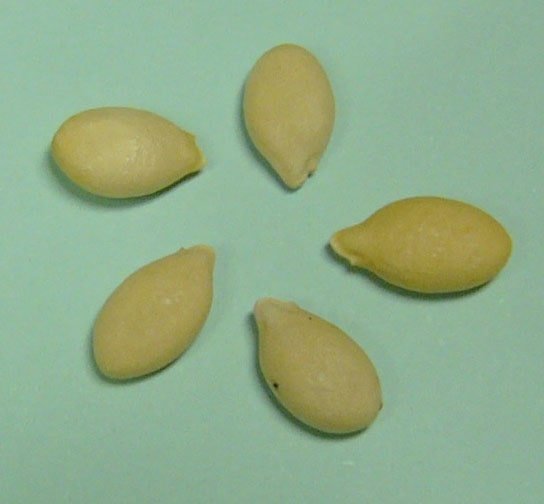
You can start a crop either by seedling or by sowing directly. If you use seedlings, you’ll get the advantage of a slightly earlier production, typically, a month and a half earlier than when you start by seeds.
If you choose seedlings, make sure you plant them with about six weeks before you estimate that it is safe to transplant them. Also, ensure you keep them in a warm place. The seeds will germinate faster at temperatures between 85-95°F (30-35°C).
Once the plants are large enough (typically when the seedlings have developed about 4-5 full leaves, excluding the seed leaves), you can transplant them in your garden or the chosen spot.
When planting, leave a space of approximately 1.2 m between the rows, and about 60 cm to 1m between the plants. That should give the winter melons enough room to expand their vines.
Winter melon is a heat-loving plant, so make sure you choose a sunny place where the sun rays can fully reach the plant throughout the whole day. Yet, if you live in a region where it’s continuously extremely hot, you can plant it in a slightly shaded area.
Soil Type
Winter melons grow best in slightly acid soil with a pH level in the 5.5-6.5 range. It also needs to be well-drained and rich in organic matter.
If your garden soil is not very nutrient-rich, you can always add manure or compost to improve its fertility. If you are interested in learning how to make compost at home from food scraps, read this guide.
To give the plants a boost, you can also add some fertilizer. A 10-10-10 all-purpose fertilizer (10% nitrogen – 10% phosphorus – 10% potassium) should do just fine.
Watering
Winter melons need a good amount of water for healthy growth, especially during the fruit forming period. Yet, they also need well-drained soil, so make sure you don’t overdo it.
Try to keep the foliage and fruit dry when watering. Splashing the leaves and fruit with dirt might lead to the occurrence of fungal diseases over time, especially if your plants are growing directly over the surface of the ground.
It’s best to make a regular watering schedule based on the climate in your region and give your winter melons enough water to keep the soil evenly moist.
Diseases and Pests
Except for the common bugs and worms that attack any garden plant, there aren’t any special pests that particularly target the winter melon crops as far as I know. This might not apply, however, to all the regions of the world. Since it has been cultivated for thousands of years in different regions of Asia, there might be more pests in that part of the world that like to consume the winter melon in particular.
Generally, you need to watch for:
- Spider mites
- Leafhoppers
- Aphids
- Beetles
- Squash bugs
- Snails
- Slugs
- Squash vine borer
In general, you should watch for any other pest that targets squashes, pumpkins, and cucumbers. Consequently, I recommend you avoiding planting the winter melons near these or any related vine plants.
Besides pests, winter melons are susceptible to various diseases. Some of the common conditions affecting these plants are:
- Powdery mildew
- Downy mildew
- Root rots
- Alternaria blight
- Angular leaf spot
- Septoria leaf spot
- Phytophthora blight
and more.
Pruning
For the winter melon plant to produce healthier fruits, you should consider pruning the plants. You should also remove the yellow leaves at the base of the plant and the ones affected by diseases or pests. This will enable the plant to redirect more resources to the vital parts of the plant and boost fruit development.
For more details about how to prune the vines of winter melons and other useful advice on how to grow this plant, watch the following video from Asian garden 2 table.
Harvesting
Depending on the variety, some fruits will grow larger while others will remain smaller. Therefore, unless you know the variety well, the size of the fruit is not always the best indicator whether it’s harvesting time or not.
When mature, many varieties develop a white powder coating. That can be an indicator that the fruit is ready to be picked up.
However, probably the best time to harvest the winter melon fruits is when all the leaves turn yellow almost entirely.
On average, it takes between 4 and 6 months (90-110 days on average) for winter melons to reach harvesting time. This timeframe might, however, vary based on climate, whether you have started your crop from seeds or seedlings, soil fertility, and so on.
Storage
One of the advantages of winter melons is the fact that someone can store it for considerable periods. In the appropriate conditions, you can enjoy winter melons for roughly 5-6 months. Just place the harvest in a relatively cool, dry place. The optimal temperature is between 55-60°F (13-15°C).
After you cut the fruit open, you should consume it in maximum a week.
Final Word
Growing winter melons is not extremely hard if you know the requirements of these plants. Follow the information covered in this guide and you can enjoy this exotic fruit for an extended period after harvest.
I hope you’ll find this article helpful and maybe give you an initial boost for starting your own crop of winter melons.
Have you ever tried to grow winter melons?
Don’t forget to leave a comment with your thoughts about this not very common type of crop.
References:
- Winter Gourd, Ontario Ministry of Agriculture Food and Rural affairs – Link
- Asian garden 2 table YouTube Channel – Link
- Winter melons: A new crop for Michigan growers – Link
